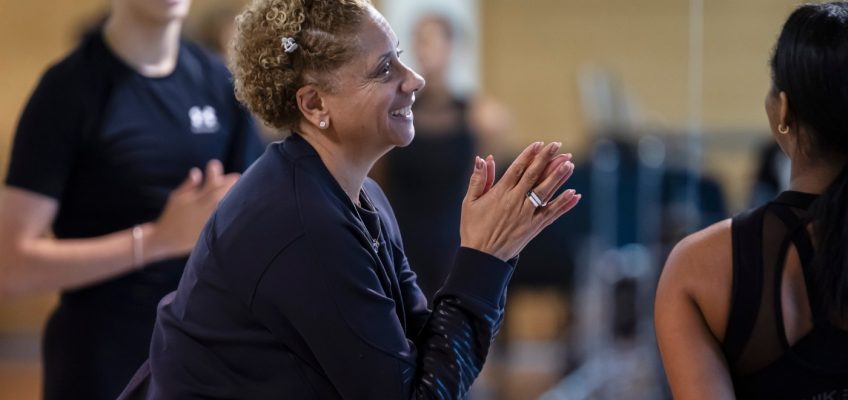The photo is black-and-white: Toni Pierce-Sands and her sister, both young children, are sitting on a stoop at their grandparents’ farmhouse in rural South Dakota.
Her sister looks shy, turned inward. Meanwhile, as Pierce-Sands described, she herself looks anything but: Her limbs are splayed out, her face in a goofy expression.
“When I look back at that photo, I don’t even know what’s happening,” she said, laughing.
Her mother recognized this performative urge and enrolled the 6-year-old at the Contemporary Dance Playhouse, the organization that founder Loyce Houlton later renamed Minnesota Dance Theatre.
During one early class, the teacher, dancer Marcia Chapman, performed a reach.
“I have this memory, but especially now, how many years later, I don’t know if I made it up or if it’s real,” Pierce-Sands said. “But I feel like she offered her hand to me. Like, ‘Do you want to dance with us?’”
However this moment actually played out at the time, Pierce-Sands said the sense of an invitation felt like an epiphany.
Yes, she did want to dance.
She felt free and safe and full — “you’re reborn as yourself and everything makes sense,” she said — as she moved across the stage.
Years later, Pierce-Sands moved to New York and joined the Alvin Ailey American Dance Theater, one of the country’s most prestigious modern dance companies. For nearly a decade, she danced professionally in New York and toured around the world; photos of her sit in the archives of the Smithsonian Institution.
And after moving back home to St. Paul, she co-launched TU Dance, which is now composed of a 10-member professional dance company, a pre-professional training program and a school that leaders estimate has taught more than 4,000 students, all headquartered in a sunny industrial building at 2121 W. University Ave.
To mark the 20th anniversary of TU Dance this year, the organization is holding celebratory performances of works by landmark Black choreographers, on April 25 and 26 at the O’Shaughnessy at St. Catherine University.
Dances in the show will include “Witness” by Alvin Ailey, excerpts from “Four Corners” by Ronald K. Brown and “New Second Line” by Camille A. Brown and “Ma,” a duet from Alonzo King’s “Who Dressed You Like a Foreigner?”
Tickets for the shows, which begin at 7 p.m. both nights, are $40 for general admission, $20 for students or $30 for seniors, with 50 percent off the regular ticket price for groups of four or more (using the code TUx2). Tickets can be purchased at the theater’s box office (2004 Randolph Ave), by phone at 651-690-6700 or online at oshag.stkate.edu/events.
“The program that we’re putting together, nobody else is doing work like this,” TU Dance executive director Abdo Sayegh Rodriguez said. “I’m happy that we are stable, that we have good energy, and my hope is that people will come to the theater and enjoy the performance and celebrate our journey.”
Toni Pierce-Sands, Founder and Artistic Director of TU Dance, works with high school junior and senior dance students during a class at the TU Dance Studio in St. Paul on Tuesday, Feb. 25, 2025. (John Autey / Pioneer Press)
“You either hit it or you don’t”
For Pierce-Sands, other childhood moments felt like invitations, too.
In one memory, dancer Mary Hinkson, a longtime member of the famed Martha Graham Dance Company, visited Minnesota Dance Theatre. Pierce-Sands does not recall precisely how old she was, but she said it was the first time she had seen a Black woman performing modern dance.
In another memory, some years later, the renowned choreographer Alvin Ailey and several members of his predominantly Black dance company were rehearsing at the studio. Pierce-Sands was standing with her sister, watching from the doorway. One dancer, Beth Shorter, put her hand on Pierce-Sands’ arm and said to the girls, “Hi beauties, you can come in.”
“There was another moment of, ‘Ah! I can see myself doing this.’ There I am, there she is; there we are,” Pierce-Sands said. “These signals, guiding angels, whatever you want to call them, are directing and welcoming me into my life.”
And by the time Pierce-Sands was a teenager, it had become quite clear that she was herself a prodigious dancer.
One more memory: During her senior year of high school, Dance Theatre of Harlem, considered the first Black classical ballet company, performed at Northrop Auditorium. Before showtime, director Arthur Mitchell invited Pierce-Sands for a private audition with the principal male dancer, an opportunity that was much more prestigious than she realized at the time.
She was offered an apprenticeship in New York City, so she moved across the country — but ultimately never danced a day with Dance Theatre of Harlem. She had arrived in the city a bit early and figured, since she was already in town, why not head over to the Alvin Ailey American Dance Theater and audition there, too? Turns out, Ailey’s company also wanted her for its summer intensive, and they told her just in time. It was on the very day she was supposed to start at Dance Theatre of Harlem, she recalled, that she made the last-minute choice to report to Ailey’s theater instead.
It turned out to be a good decision: Within two weeks, Pierce-Sands was promoted from the summer program into Alvin Ailey Repertory Ensemble, the junior company now called Ailey II. Two years later, she was elevated to the main company, which was directed by Ailey personally and far more rigorous than anything she’d experienced.
“It was like, ‘OK, y’all thought you were cute? You have a seat; I’m going to show you,” Pierce-Sands said. “The way they talked, it’s ‘5,6,7,8 —’ and you either hit it or you don’t. I had enough training, enough formation, so I jumped and landed. You land and you go. There’s no time for asking and answering questions.”
After a couple years dancing under Ailey, Pierce-Sands moved to Germany to dance for three years, then to Paris for five, then back to New York City to rejoin the main Ailey company for a few years in the mid-1990s.
By this point, things had changed: Pierce-Sands had a young son, who was born during her time in Paris. She’d become engaged to Uri Sands, a fellow Ailey dancer and budding choreographer. Alvin Ailey himself had died in 1989. And Pierce-Sands was ready to return home to St. Paul.
“We come back to Minnesota and we sit down in the audience and look around, and we’re the only people of color,” Pierce-Sands said. “And from when I grew up to when I came back, the Twin Cities had really diversified — but that wasn’t being represented in dance, both from an audience perspective and also the artists. So we started questioning that.”
Toni Pierce-Sands, Founder and Artistic Director of TU Dance, helps a dancer with her foot position during a class of high school juniors and seniors at the TU Dance Studio in St. Paul on Tuesday, Feb. 25, 2025. (John Autey / Pioneer Press)
‘A gamechanger from the beginning’
The 1994 holiday season was approaching, and Minnesota Dance Theatre artistic director Loyce Houlton needed to fill a key male role in the company’s long-running Nutcracker Fantasy show.
She asked a visiting dancer, Venezuelan ballerina Leticia Guerrero, if she had any ideas. Yes, Guerrero said: You should invite a rising ballet star in Caracas, Abdo Sayegh Rodriguez.
After three years performing in the Nutcracker Fantasy as a guest artist, Sayegh Rodriguez was invited by MDT’s new leader, Houlton’s daughter Lise Houlton, to move to Minnesota for good as a full-time company member. He agreed.
Shortly thereafter, MDT brought on a new teaching artist and rehearsal assistant for modern dance — a hometown girl who’d made it big in New York with the Alvin Ailey American Dance Theater, Toni Pierce-Sands. And Uri Sands, soon to become her husband, joined her in the Twin Cities about a year later, dancing in MDT’s main company alongside Sayegh Rodriguez and choreographing work for the company. The three quickly became good friends.
“Toni’s family friend had a cabin up north, and they would invite me to hang out for long weekends,” Sayegh Rodriguez said. “We started talking about dance and the philosophy of dance and the state of dance in Minnesota and the lack of representation — the fact that I was one of the only professional Latino dancers in the community. So these conversations prompted Toni and Uri to start a dance project.”
The project — something to keep their creative juices flowing during the summer off-season — was called “Space T.U. Embrace.” In 2002, Pierce-Sands and Sands recruited a group of local and national dancers of color, including Sayegh Rodriguez, and sold out the Barbara Barker Center for Dance at the University of Minnesota. The next summer, they did it again, and the year after, they remounted the work at a sold-out Southern Theater.
“There was desire from audiences for more: Why do Toni and Uri only do one show a year?” Sayegh Rodriguez said.
So in 2004, the couple started planning to launch a dance company of their own.
And from the moment the curtains opened on TU Dance’s premiere as a formal company in 2005, it was clear Pierce-Sands and Sands had created something vibrant and urgent. The choreography, a critic for the Pioneer Press opined in 2005, created “highly textured and nuanced testimonials to what dance, purely and simply, is all about — human interaction.” And in subsequent years, reviewers continued to praise dancers’ skill at negotiating race and identity through movement.
“Part of the inspiration of TU Dance was a gesture to the community from which I came,” Pierce-Sands said. “How does TU Dance become an invitation, is what we would say: An invitation for someone who had never thought about dance or come to see a dance performance.”
But Pierce-Sands and Sands quickly realized why they had not seen much diversity among dancers onstage in other companies: Many skilled Black ballet and modern dancers simply didn’t live in the Twin Cities, so companies had to pay to fly them in for rehearsals and performances — a tall order for frequently cash-strapped arts nonprofits.
Sayegh Rodriguez, who by the late 2000s had become the associate artistic director of Minnesota Dance Theatre and was still one of its only dancers of color, recalls running into the same challenge there. (Despite helping with earlier projects, he himself was not able to join the founding TU Dance company due to his long-running commitments with MDT.)
“It’s not that our director didn’t want (diversity); it’s that she couldn’t afford to bring people from other cities and pay them the money they’d get in New York or Boston or San Francisco,” he said. “I remember early auditions for TU Dance, too: Some beautiful dancers, but we would’ve ended up having a basically white company.”
By the time TU Dance marked its fifth anniversary, it became clear that TU Dance would have to train the next generation of dancers of color itself.
In 2011, the organization moved into its current rehearsal space on University Avenue and prepared to launch a dance school. Meanwhile, Sayegh Rodriguez had been laid off by Minnesota Dance Theatre, and he took on a more active role in helping establish TU Dance’s education program. In 2012, he joined the organization full-time as managing director and became executive director in 2020.
Sands stepped down from TU Dance in late 2019 following an accusation of sexual harassment by a former dancer and employee. He and Pierce-Sands remain married but Sands has not been affiliated with TU Dance since his resignation.
It makes for a complicated dynamic, one Pierce-Sands does not like to discuss. TU Dance, she said, owes much of its early success to the strength of Sands’ choreographic skill. At the same time, she said, she believes the company’s mission — to not just create dance, but to cultivate stronger individuals and communities through dance — has become the source of TU Dance’s staying power, more so than the people leading it.
“TU Dance should be beyond us,” she said. “It’s not dependent on Uri Sands. It’s not dependent on Toni Pierce-Sands. … There are people in the dance community now who I don’t (recognize), and I’m like, ‘Wow, this is great,’ because it’s a signal of time. I’m so humbled by the fact that I’ve been able to be a part of shifting who’s in the audience and who’s on stage.”
Toni Pierce-Sands, Founder and Artistic Director of TU Dance, keeps an eye on her class of high school juniors and seniors dancers at the TU Dance Studio in St. Paul on Tuesday, Feb. 25, 2025. (John Autey / Pioneer Press)
‘Cultivating relationships around dance’
When TU Dance premiered its first show, in 2005, it was the new kid on the block.
At the time, the Twin Cities’ dance scene was headlined by a power trio of repertory companies — Minnesota Dance Theatre, the James Sewell Ballet and Zenon Dance — and populated by a variety of long-standing ethnic dance organizations and choreographer-driven projects.
But now, in 2025, TU Dance exists in a very different local dance world than the one that existed 20 years ago.
Today, none of those three main companies exist in the forms they once did: Zenon Dance folded in 2019; Minnesota Dance Theater closed its professional company last year and now operates as just a school; James Sewell Ballet members danced the company’s farewell show just this month. One of the Twin Cities’ preeminent dance theater spaces, the Cowles Center, also closed last year, and dance organizations of all sizes — including TU Dance — have seen audience numbers and funding diminish during the Covid era.
“The fact that we’re still around and, thank God, financially stable is a great celebratory opportunity, but with humbleness,” Sayegh Rodriguez said. “It makes me sad, though. You don’t want anybody to not exist anymore. It’s good for us to be conscious in how we celebrate this, and we cannot take it for granted.”
You can interpret the precarity of the Twin Cities dance scene any number of ways, Pierce-Sands said. Maybe it was Covid. Maybe we’ve all become more isolated. Maybe big funders have dropped away, and maybe fewer choreographers can make a stable living by producing work to be danced to.
Or maybe, frankly, the traditionally hierarchical repertory company model doesn’t provide what dancers today need. When Pierce-Sands and her generation of dancers were coming up, she said, “we developed as dancers and hoped to God that we developed as human beings along the way. But I think that’s shifted.”
TU Dance, she said, cannot just be about dancing: Besides training dancers to move beautifully across the stage, she has a responsibility to teach them to move through the world as good people and community members, too. This, she said, is what has kept and will continue to keep TU Dance relevant.
“We’re not just producing dance; we’re cultivating relationships around dance,” Pierce-Sands said.
And like the choreographical lineup for TU Dance’s 20th anniversary show next month, this ethos is inspired by Pierce-Sands’ years dancing under Alvin Ailey.
“Mr. Ailey did the simplest thing: He just thought about humanity, and dancers of color having access to dance their story and their history,” she said. “Because we are all a part of each other’s story.”
Toni Pierce-Sands, Founder and Artistic Director of TU Dance, listens to a student dancer at the TU Dance Studio in St. Paul on Tuesday, Feb. 25, 2025. (John Autey / Pioneer Press)
‘Wicked,’ ‘The Great Gatsby’ and ‘Les Miserables’ on tap for new Broadway on Hennepin season
Michael Brindisi, longtime Chanhassen Dinner Theatres artistic director, dies at 76
‘Dealing With Dragons’ captures humor of beloved Minnesota-grown children’s fantasy novel




